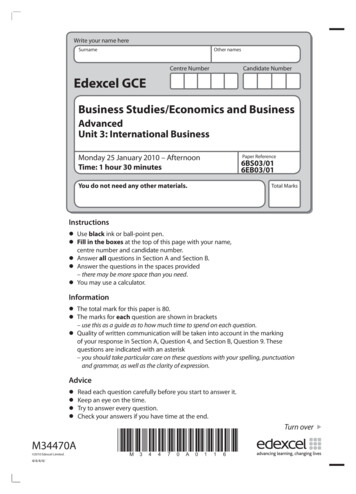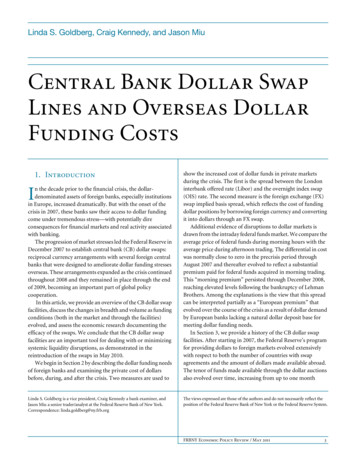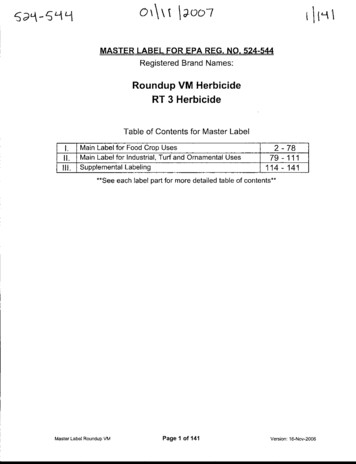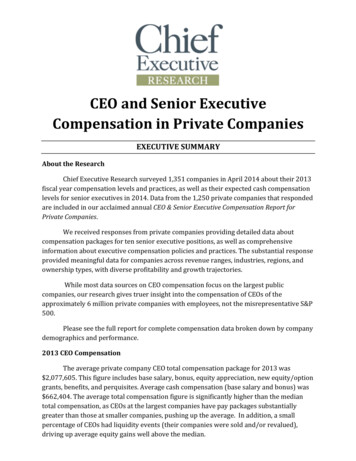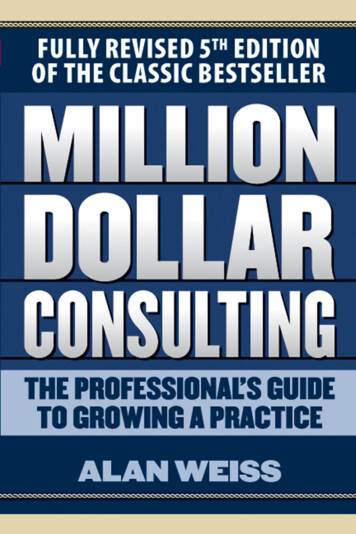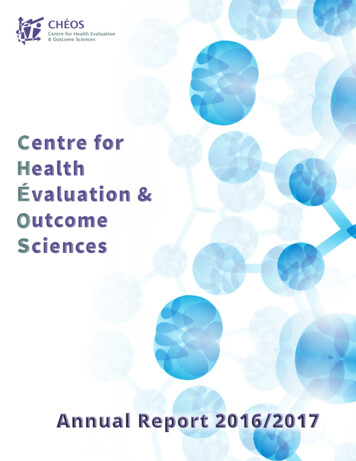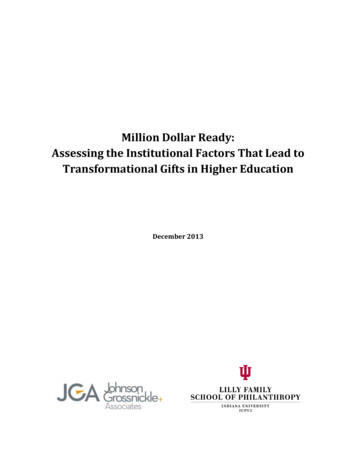
Transcription
Million Dollar Ready:Assessing the Institutional Factors That Lead toTransformational Gifts in Higher EducationDecember 2013
AcknowledgmentsThis report was researched and written byThe Indiana University Lilly Family School of Philanthropy Project TeamUna Osili, Ph.D., Director of ResearchJacqueline Ackerman, Project CoordinatorAdriene Davis Kalugyer, Manager of Public AffairsCynthia Hyatte, Administrative AssistantYannan Li, Research AssociateKayle Lewis, Research AssociateStephen Carnagua, Research AssociateThomas Pearson, Research AssociateWith special thanks to Xiaonan Kou, Amir Hayat, Melanie McKitrick,and Amy Thayer for their review and comments.About the Indiana University Lilly Family School of PhilanthropyThe Indiana University Lilly Family School of Philanthropy is dedicated to improving philanthropy byeducating and empowering students, professionals and volunteers to be innovators and leaders whocreate positive and lasting change in the world. The first of its kind in the world, the School offers acomprehensive approach to philanthropy — voluntary action for the public good — through itsacademic, research and international programs and through The Fund Raising School, Women’sPhilanthropy Institute and Lake Institute on Faith & Giving. Learn more at www.philanthropy.iupui.edu.“Improving Philanthropy to Improve the World”1
This analysis and report was made possible through a research partnership withThe Johnson, Grossnickle and Associates Project TeamAngela White, Senior Consultant and CEOTed Grossnickle, Senior Consultant and FounderKris Kindelsperger, Senior Executive ConsultantDeanna Lepsky, Marketing DirectorJeff Small, Project ManagerAbout Johnson, Grossnickle and AssociatesSince 1994, Johnson, Grossnickle and Associates has taken an authentic, strategic approach to providepremier philanthropic consulting services to private colleges, seminaries, independent schools, and largecultural, community and health organizations. Our firm specializes in assisting larger nonprofit groupswith capital campaigns, development audits, feasibility studies and general fundraising counsel.JGA believes in strengthening the field of philanthropy through research and empowering nonprofits tomake the world a better place. We know the field of philanthropy continues to evolve and we are partof that evolution. Our consultants are teachers, students, authors, and frequent speakers on the latesttechniques and philosophies in the field. We invite you to learn more about our services on our websiteat www.jgacounsel.com, and we look forward to partnering with you on your philanthropic journey.2
ContentsAcknowledgments. 1Executive Summary. 4Key Findings . 4Conclusion . 6Introduction . 7Million Dollar Gifts Analysis . 8Rank and Age . 9Leadership . 10Alumni and Students . 11Faculty and Staff . 12Institutional Finance . 13Institutional Attributes. 14Classification . 14Geography/Location . 15Case Studies in Million Dollar Giving to Higher Education . 16Arizona State University. 16DePauw University . 17Massachusetts Institute of Technology . 19Case Study Themes . 21Implications . 23Areas for Further Research . 24Conclusion . 25Appendix I: Previous Research . 26Appendix II: Methodology and Data . 28About the Million Dollar List . 29Appendix III: References . 30Appendix IV: Statistical Tables . 31Descriptive Statistics . 31Baseline Regressions . 34Other Regressions . 403
Executive SummaryMillion-dollar donations have the ability to transform higher education institutions to deliver on theirmissions. However, less than one in three degree-granting higher education institutions in the U.S.received a publicly announced million-dollar donation from 2000 through 2012. Even fewer institutionsreceived a multiple such gifts. Cultivating such gifts is a complex, time-consuming process – but reaps anenormous payoff.In the past, research on million-dollar giving has focused on donors and the factors that led them togive. This report turns the tables, in effect, identifying the characteristics of the higher educationorganizations that consistently attract million-dollar-plus gifts – in other words, striving to understandwhat makes them “Million Dollar Ready.”This analysis explores two dependent variables: the number of million-dollar-plus gifts received by aninstitution from 2000 to 2012, and the total aggregated value of those gifts. The following independentvariables were included as controls: liberal arts institution, doctoral or research university, and CarnegieClassification. To determine which institutional factors are actually causing the changes in million-dollargiving, the study looks at how a key indicator in 2000 or 2001 (such as ranking, endowment value, etc.)affects the total number and total value of million-dollar-plus gifts over the entire period 2000 to 2012.For all findings, factors other than those specifically referenced were held constant. Statistical controlswere analyzed for all results detailed in the text, specifically by Carnegie Classification. Other controlsanalyzed include controls for liberal arts and doctoral/research institutions. If controls other thanCarnegie Classification were used, those instances are noted in the text.This report aims to identify the factors that influence million-dollar gifts within higher educationorganizations through a comprehensive quantitative analysis of a unique dataset that combines MillionDollar List data on transformative gifts to higher education with data on the institutions receiving suchgifts. Additionally, the study explores the driving forces behind such giving through in-depth case studiesof three universities that have received million-dollar gifts: Arizona State University (ASU), DePauwUniversity (DePauw), and Massachusetts Institute of Technology (MIT).The particular data and methodology used in this study place limitations on how the findings should beapplied. The study uses data on gifts of 1 million or more from public announcements, which means itdoes not analyze every gift of this size given to a higher education institution, since not all such gifts areannounced. Further, the data used are specific to higher education institutions. Finally, the study looksat gifts of 1 million or more, and findings may not apply to institutions that receive no or very few giftsat this level.This is one of the first studies to use both quantitative and qualitative methods to explore the role oforganizational leadership, board composition, strategies, sectoral trends, and other factors in order toexplain success in obtaining million-dollar-plus gifts.Key FindingsIt starts at the top Longer presidential tenure is associated with higher numbers of million-dollar-plus donations.An institution with a president in office since 2000 tended to receive a higher number of milliondollar donations during the study period of2000-2012, holding other factors constant.4
Case studies suggest that a president’s ability to articulate a powerful vision and connect it todonors’ motivations will have a profound effect on million-dollar gift success.Rankings and age matter It appears that rank – as in an institution’s inclusion on “Best Colleges” listings – does influencedonors. A national ranking* in the year 2000 is associated with a 61 percent increase in thenumber of million-dollar gifts received by a college or university, and a 156 percent increase inthe total value of those gifts from 2000 to 2012, holding other factors constant.Institutions founded prior to 1900 received a higher number and greater value of million-dollardonations over the study period compared with institutions founded since 1900. Institutionsfounded between 1900 and 1950 received about 13 percent fewer million-dollar gifts, andinstitutions founded since 1950 received 12 percent fewer million-dollar gifts relative to theoldest institutions, holding other factors constant.Enrollment and alumni giving play a role An increase of 1,000 enrolled students in 2001 is associated with a 1 percent increase in thenumber of million-dollar gifts over the 2000-2012 study period, and with a 2 percent increase inthe total value of these gifts, holding other factors constant.The study found a correlation between alumni giving and million-dollar gifts: A 10 percentincrease in average alumni giving in 2001 is associated with a 0.7 percent increase in the numberof million-dollar gifts between 2000 and 2012, holding other factors constant.However, case studies show this does not mean that small schools cannot attract major gifts, orthat alumni are the sole source of major gifts. Although it has only 2,300 students, DePauwUniversity has attracted a number of million-dollar-plus gifts (seven publicly announced gifts of 1 million or more from 2000 to 2012, according to an analysis based on the Million Dollar List).On the other hand, while Arizona State University has approximately 300,000 alumni worldwide,it reports that a good portion of its million-dollar-plus gifts (the university received 53 gifts of 1million or more during the study period) comes from people who did not attend the school.Invest in people and reap rewards Institutions that invest in more tenured faculty and that spend more on employee expenses aremore likely to attract million-dollar contributions. Higher levels of tenured faculty and employeeexpenses in 2001 were associated with higher million-dollar-plus gift receipts from 2000 to2012, holding other factors constant.Solid finances attract more gifts *Endowment value in 2001 is positively associated with the number of million-dollar giftsreceived and with the value of those gifts from 2000 to 2012, holding other factors constant.While the total value of an institution’s assets doesn’t seem to affect the number of milliondollar-plus gifts received, it is associated with the total value of those gifts.While some studies have suggested that government funding “crowds out” privatephilanthropy, the Million Dollar Ready study suggests this may not be the case. The study foundthat the amount of government funding received by an institution in 2001 positivelyFor the purposes of this study, the U.S. News & World Report “Best Colleges” rankings5
corresponds with both the number and total value of million-dollar gifts made to the institutionfrom 2000 to 2012, holding other factors constant.Institution type has an impact Liberal arts institutions, as well as doctoral or research universities, received both more milliondollar gifts as well as higher total values of such gifts from 2000 to 2012 compared with othertypes of institutions, other factors held constant.The study also noted that Historically Black Colleges and Universities received fewer milliondollar gifts than other institutions during the research period, with other factors held constant.Location, location, location Rural institutions received 11 percent fewer million-dollar gifts compared to non-rural collegesand universities from 2000 to 2012, and schools in the Southern and Western regions of the U.S.fared better than those in the Northeastern region, other factors held constant.ConclusionCompared to other types of nonprofit organizations, higher education institutions receive million-dollardonations more frequently. However, only about one in every three (30 percent) degree-granting highereducation institutions in the U.S. is identified on the Million Dollar List as having received such a giftbetween 2000 and 2012.Our analysis indicates that several factors influence the ability of colleges and universities to attractthese high-level donations. Key factors appear to be ranking, presidential tenure, board giving, the ageof the institution, and investment in staff and resources.The case study analysis allows us to explore these factors in more depth. Case studies consistently citedthe student experience, the president’s vision for the institution, and the impact of other key players(such as the institutions’ foundation and advancement staff, board members, and faculty) as having amajor impact on the volume of million-dollar gifts brought into an institution.With a still-recovering economy and an increasing reliance on private giving, million-dollar-plus gifts arenot only of vital importance to these recipient institutions but also signify the trust and confidence thatdonors have in these institutions. Colleges and universities across the U.S. can use these results tobenchmark themselves against their peers, and determine areas in which they may be lagging. Thisreport not only provides insights into the workings of institutional development and advancement, butalso gives a picture of what donors look at when deciding how to invest philanthropically in a college oruniversity.6
IntroductionPhilanthropy in higher education is changing rapidly in response to key economic and societal issues. Forcolleges and universities, as well as their donors, important questions on the role of large gifts in highereducation are of growing interest. Studies show that large gifts by high net worth donors account for alarge share of all philanthropic dollars (Havens & Schervish, 2001). The top 10 percent of donorscontribute 93 percent of all private philanthropy to higher education – up from 84 percent a decade ago(CASE, 2011). At the same time, million-dollar gifts to higher education are relatively rare – only about30 percent of degree-granting institutions in the U.S. have received such a gift since 2000.Million-dollar gifts have the ability to transform an institution to deliver on its mission. One examplecited by Murray (2012) is the 100 million donation from David H. Koch to the Massachusetts Instituteof Technology in 2007, which was given for the construction of the David H. Koch Institute forIntegrative Cancer Research as well as other research projects. Many gifts to higher education also fundscholarships and fellowships, such as the 33.3 million donation from by Bill and Melinda GatesFoundation to the University of Washington in 2005, which provided scholarships for law students. Giftslike these transform the institution to which they are given and allow it to expand its services andmission. Despite the many gifts that have been announced in recent years, few studies have investigatedthe characteristics that make an organization more likely to receive gifts at this level.This study seeks to identify factors that influence higher education institutions success in obtainingmillion-dollar gifts. The study relies heavily on the Million Dollar List, a unique dataset housed at theIndiana University Lilly Family School of Philanthropy. This is one of the first studies to use bothquantitative and qualitative methods to explore the role of organizational leadership, boardcomposition, strategies, sectoral trends, and other factors in order to explain success in obtainingmillion-dollar-plus gifts.The central question addressed in our report is:What characteristics make a higher education institution more likely to receive a million-dollar gift?The report seeks to answer this question through a comprehensive quantitative analysis of a new andunique dataset combining Million Dollar List data on transformative gifts to higher education with datafrom other industry resources on the institutions receiving such gifts. This analysis helps to shed light onthe various factors influencing the receipt of million-dollar gifts. Additionally, the study explores thedriving forces behind such giving through in-depth case studies of three universities that have receivedmillion-dollar gifts. This research aims to fill the gaps in knowledge about how and why certaininstitutions are successful at attracting multiple million-dollar gifts.7
Million Dollar Gifts AnalysisThrough an empirical analysis of a unique data set, we investigate the factors that influence the numberand total value of million-dollar gifts to colleges and universities.We developed a unique data set with which to analyze million-dollar giving to higher education byanalyzing data from the Million Dollar List as well as from sources such as the IPEDS Data Center, theVSE survey by the Council for Aid to Education, and U.S. News & World Report. While the Million DollarList data has been analyzed in a number of ways, and there are many sources of data about highereducation institutions, these resources had previously not been combined to form a data set whichallows for an analysis of million-dollar giving to this sector. The new data set provides the opportunity toexplore the very highest level of philanthropy to these institutions, and to provide important insights toinstitutions seeking these gifts.Our analysis explores two dependent variables: the number of million-dollar-plus gifts received by aninstitution over 2000-2012, and the total aggregated value of those gifts. Certain factors discussedbelow influence both the number and total value of gifts, and other factors may influence either thenumber or the total value.Independent variables were chosen based on the literature and on our theoretical models. Theseindependent variables included: board average giving, alumni average giving, assets, endowment size,level of government funding, number of enrolled students, full-time employees, percentage of facultywith tenure, employee expenses, institution age, presidential tenure, rank, control of institution (publicor private), location, and whether an institution was a Historically Black College or University (HBCU), aswell as other control variables mentioned below. Independent variables were mentioned in 2000 or2001 (depending on data availability) so that we could determine causality and impact on thedependent variables.We include the following independent variables as controls: liberal arts institution, doctoral or researchuniversity, and Carnegie Classification. All analyses detailed below include controls for CarnegieClassification unless otherwise noted. All findings are significant the 0.1 level or lower unless otherwisenoted (i.e., the p-value is less than or equal to 0.10); this means we can say with 90 percent confidencethat the results are not due to chance. We discuss the meaning of each variable and indicate that resultsare accurate “holding other factors constant”. This means that we know a certain variable impactsmillion-dollar giving to higher education, even after we take into account other factors that we knowaffect this million-dollar giving.Please see the statistical tables in Appendix IV for specific coefficients and levels of significance.The baseline analysis models were estimated using median regression because this method is morerobust against outliers, and we anticipate that our dependent variables are not normally distributed. Toexamine the robustness of our results, we also conducted the analyses using ordinary least squares(OLS) regression, and analyzed the number of million-dollar gifts using Poisson regression analysis. Eachof these analysis tables is available in Appendix IV. A more detailed description of the methodology anddata used in the study is in Appendix II.Our findings are discussed in detail below, ordered by theme.8
Rank and AgeWe explore the impact of the ranking of a college or university, as well as its age. The table belowsummarizes indicators that show statistically significant relationships with million-dollar-plus gifts.Ranking (in 2000, ranked orunranked by U.S. News & WorldReport)Age of institution: medium(founded 1900-1950)Age of institution: young(founded 1950-present)NPseudo R2Number of 1m Gifts(2000-2012)Value of 1m egative**-12750.37012850.347*Age of institution: medium has a negative, significant relationship when controlling for whether an institution is a doctoral or2research university, rather than the Carnegie Classification (used for all other variables). To see applicable N and Pseudo Rvalues, please see Table 8 in Appendix IV.**Age of institution: young has a negative, significant relationship when controlling for whether an institution is a liberal arts2institution, rather than the Carnegie Classification (used for all other variables). To see applicable N and Pseudo R values,please see Table 8 in Appendix IV.The ranking of an institution is highly statistically significant and is positively associated with both thenumber and the total value of million-dollar gifts received. We use rankings in our analysis to signal thequality and reputation of an institution. We use U.S. News & World Report rankings for the year 2000,and evaluate whether being ranked (a dummy variable, not the level of an institution in the rankings)influences million-dollar gifts. In our sample, about 9 percent of the institutions were on these rankingsin 2000. An institution being ranked in the year 2000 is associated with a 61 percent increase in thenumber of million-dollar gifts over the period 2000 through 2012, and a 156 percent increase in thevalue of those gifts (holding all other factors constant). An institution’s reputation, as measured by itsranking, is clearly a major factor that impacts million-dollar giving to that institution.We categorized institutions into three age categories: old institutions (founded before 1900) made up51% of our sample; medium-aged institutions (founded from 1900 to 1950) made up 26 percent of thesample; and young institutions (founded since 1950) made up the remaining 23 percent of institutions.The age of an institution impacts both the total number of million-dollar gifts (measured in dollars) aswell as the total value of gifts received, particularly for medium-aged institutions. Being a medium-agedinstitution is associated with receiving around 13 percent fewer million-dollar gifts, and 16 percentless of the total value of million-dollar gifts, over the study period 2000 through 2012 compared to oldinstitutions (holding other factors constant). Being a young institution is associated with receiving 12percent fewer million-dollar gifts relative to old institutions, but there is no statistical significance to therelationship between being a young institution and the total value of the gifts received. This findingindicates that older, more established colleges and universities receive more million-dollar gifts, andhigher total values of those gifts.9
LeadershipWe explore the impact of a college or university’s leadership on the institution’s attraction of milliondollar gifts through two variables: the length of presidential tenure, and the average giving by boardmembers. The table below summarizes indicators that show statistically significant relationships withmillion-dollar-plus gifts.Presidential tenure: long(inaugurated before 2000)Board average giving ( in 2001)NPseudo R2Number of 1m Gifts 20002012)Value of 1m Gifts Presidential tenure: long has a positive, significant relationship when analyzed alongside additional variables which were not2used in all analyses; see Table 8 in Appendix IV for more details and for applicable N and Pseudo R values.The length of presidential tenure is positively associated with the number of million-dollar gifts receivedby an institution. We categorized institutions into three categories of presidential tenure: long tenure,where the current president has been in office since before the year 2000; medium-length tenure,where the current president was inaugurated between 2000 and 2005; and short tenure, where thecurrent president was inaugurated since 2006. About 13 percent of institutions studied had a presidentwith a long tenure, 19 percent had a president with a medium tenure, and the remaining 68 percent hada president with a short tenure. Having a president in office since before 2000 (long tenure) isassociated with receiving about 18 percent more million-dollar gifts than having a president with ashort tenure over the study period (all other factors held constant).The importance of a president’s tenure in office is related to his or her ability to form key relationshipsand communicate a vision for the future of the institution. Each of our case studies cite the presidents ofthese institutions as key influences on million-dollar giving, appearing to support our quantitativefindings.Board average giving (in 2001) also has a positive impact on the total number of million-dollar giftsreceived by an institution over the period 2000 through 2012. An increase in the average board giving isassociated with an increase in the number of gifts. An increase of 100 percent in the board’s averagegiving (i.e. a doubling of the average amount given) would be associated with a 5 percent increase inthe number of million-dollar gifts received by the institution over the study period, holding otherfactors constant. Our case studies have also supported the argument that the leadership of the board isvital to a culture of million-dollar giving.Taken together, these findings indicate that the leadership of an institution, specifically the length oftime that the president has been in office as well as the generosity of the institution’s board, has adecided impact on the institution’s success in receiving million-dollar gifts.10
Alumni and StudentsThe table below summarizes alumni and student indicators that show statistically significantrelationships with million-dollar-plus gifts.Number of students enrolled (in2001)Alumni average giving ( in2001)NPseudo R2Number of 1m Gifts(2000-2012)Value of 1m 7012850.347The number of students enrolled in an institution in 2001 is positively related to the both the numberand the total value of million-dollar gifts received by that institution from 2000 to 2012. An increase of1,000 enrolled students in 2001 is associated with a 1 percent increase in the number of million-dollargifts over the period 2000 to 2012, and with a 2 percent increase in the total value of these gifts(holding other factors constant).Average alumni giving in 2001 is positively related to the number of million-dollar gifts received by aninstitu
Million-dollar donations have the ability to transform higher education institutions to deliver on their missions. However, less than one in three degree-granting higher education institutions in the U.S. received a publicly announced million-dollar donation from 2000 through 2012
